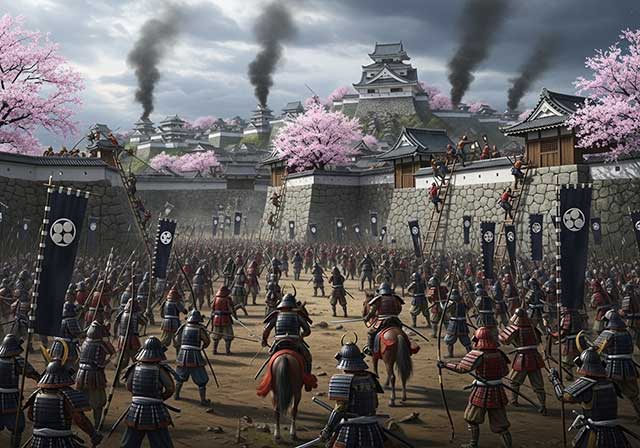
Ōuchi Yoshihiro was an influential shugo of the provinces of Suō and Nagato and played an important role as a supporter of the Ashikaga clan during the war with the Southern Court. His greatest achievement was forcing the Southern Court emperor to surrender in 1392, which brought an end to the Nanboku-chō period. This victory strengthened the Ashikaga clan's position and marked the end of the long-standing rivalry between the two imperial lines.
Despite his achievements, it was Yoshihiro who raised a rebellion against the shogunate. It was believed that the reason for this was the unfair treatment of his resources by the Ashikaga bakufu. An example of this was the shogun's demand to build a luxurious villa for himself on Mount Kiyotama, an order that placed a heavy burden on Yoshihiro's forces and resources.
As a result, Yoshihiro enlisted the support of other shugo, withdrew his troops from Kyoto, and fortified himself in the city of Sakai. He prepared for a decisive confrontation, intending to defend his position and challenge the authority of the shogunate.
Ashikaga Yoshimitsu, seeking to avoid bloodshed, first attempted to resolve the crisis peacefully. However, Yoshihiro's determination to fight was unshakeable, and the negotiations were unsuccessful.
Yoshimitsu then decided to make the first move. He assembled an army, which included forces from the Hatakeyama, Hosokawa, and Shiba clans, and advanced on Sakai. At the same time, negotiations began with the pirates of the Inland Sea, whose support the rebellious Yoshihiro was counting on. The aim of the negotiations was to organize a naval blockade of the city and deprive the enemy of supplies.
Yoshihiro's rebellion gradually began to fade. This was partly due to the swift and decisive response of the shogunate, and partly because the promised assistance from Kanrei Ashikaga Mitsukane and others never arrived. Moreover, the troops recruited in the provinces of Iwami and Izumi showed insufficient devotion and did not demonstrate complete loyalty to the rebel.
Despite the unfavorable circumstances, Yoshihiro's resistance was fierce. He stubbornly held out against the shogunate forces, and it was not until the end of 1399 that Ashikaga's troops managed to set fire to the city of Sakai.
Attacked from all sides by the combined forces of his enemies, Ouchi Yoshihiro chose the path of a samurai — he committed harakiri, remaining true to his principles until the end.
See also
-
The Siege of Hara Castle

The Shimabara Rebellion of 1637–1638, which culminated in the siege of Hara Castle, was the last major uprising of the Edo period and had serious political consequences.
-
Battle of Tennoji

The confrontation between Tokugawa Ieyasu and Toyotomi Hideyori during the “Osaka Winter Campaign” ended with the signing of a peace treaty. On January 22, 1615, the day after the treaty was signed, Ieyasu pretended to disband his army. In reality, this meant that the Shimazu forces withdrew to the nearest port. On the same day, almost the entire Tokugawa army began filling in the outer moat.
-
Siege of Shuri Castle

The Ryukyu Kingdom was established in 1429 on Okinawa, the largest island of the Ryukyu (Nansei) archipelago, as a result of the military unification of three rival kingdoms. In the following years, the state's control spread to all the islands of the archipelago.
-
The Siege of Fushimi Castle

Fushimi can perhaps be considered one of the most “unfortunate” castles of the Sengoku Jidai period. The original castle was built by Toyotomi Hideyoshi in the southeast of Kyoto in 1594 as his residence in the imperial city.
-
The Siege of Otsu Castle

The siege of Otsu Castle was part of the Sekigahara campaign, during which the so-called Eastern Coalition, led by Tokugawa Ieyasu, fought against the Western Coalition, led by Ishida Mitsunari. Otsu Castle was built in 1586 by order of Toyotomi Hideyoshi near the capital Kyoto, on the site of the dismantled Sakamoto Castle. It belonged to the type of “water castles” — mizujō — as one side of it faced Japan's largest lake, Lake Biwa, and it was surrounded by a system of moats filled with lake water, which made the fortress resemble an island.
-
The Siege of Shiroishi Castle

The siege of Shiroishi Castle was part of the Sekigahara campaign and took place several months before the decisive battle of Sekigahara. The daimyo of Aizu Province, Uesugi Kagekatsu, posed a serious threat to Tokugawa Ieyasu's plans to defeat the Western Coalition, and Ieyasu decided to curb his actions with the help of his northern vassals. To this end, he ordered Date Masamune to invade the province of Aizu and capture Shiroishi Castle.
-
The Second Siege of Jinju Castle

During the two Korean campaigns of the 16th century, the Japanese repeatedly had to capture enemy fortresses and defend occupied or constructed fortifications from the combined Korean and Chinese forces. Among all the operations of that time, the second siege of Jinju Castle is considered the most interesting from the point of view of siege warfare.
-
The Siege of Takamatsu Castle

The siege of Takamatsu Castle in Bitchu Province is considered the first mizuzeme, or “water siege,” in Japanese history. Until then, such an original tactic had never been used.

